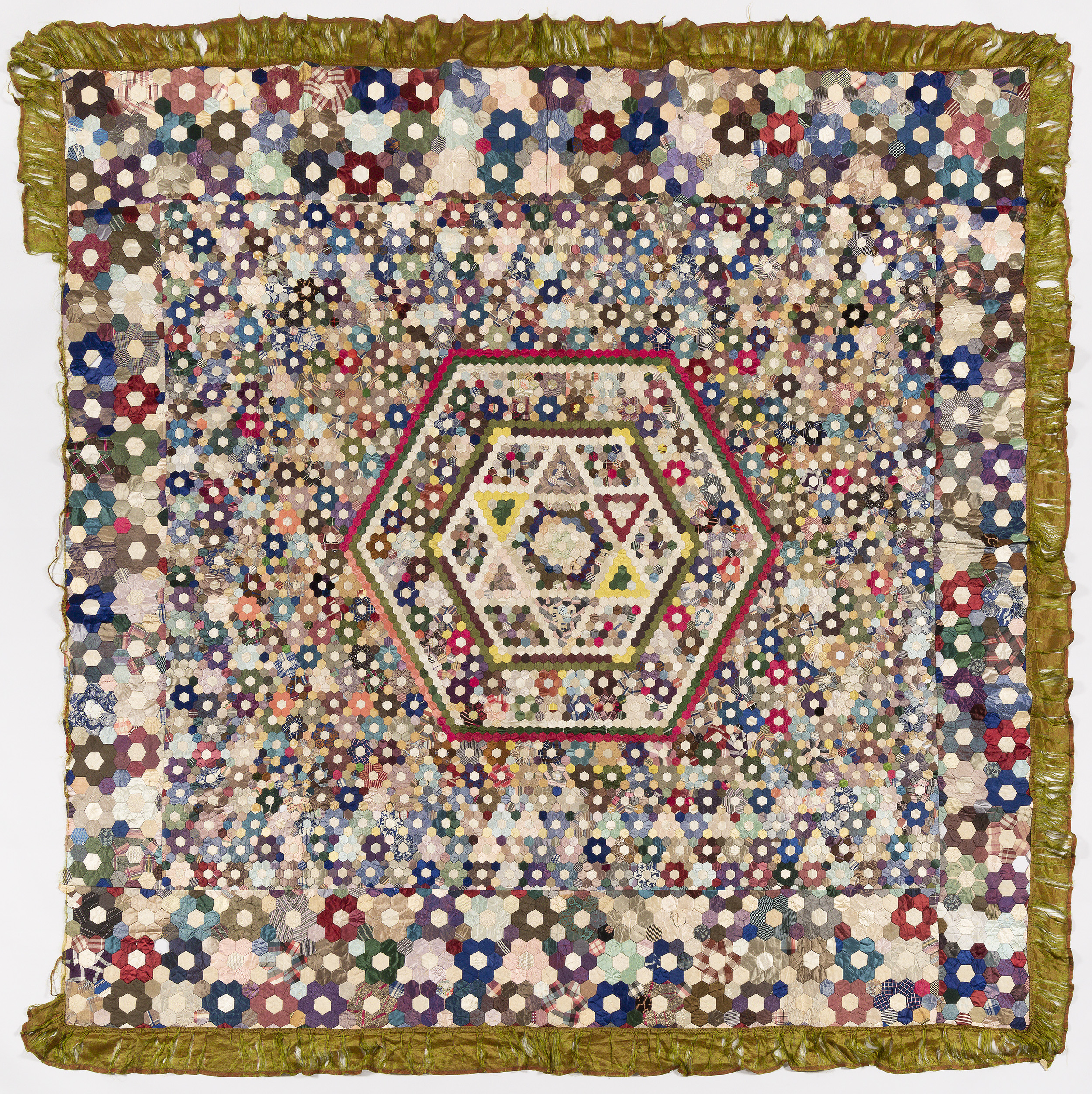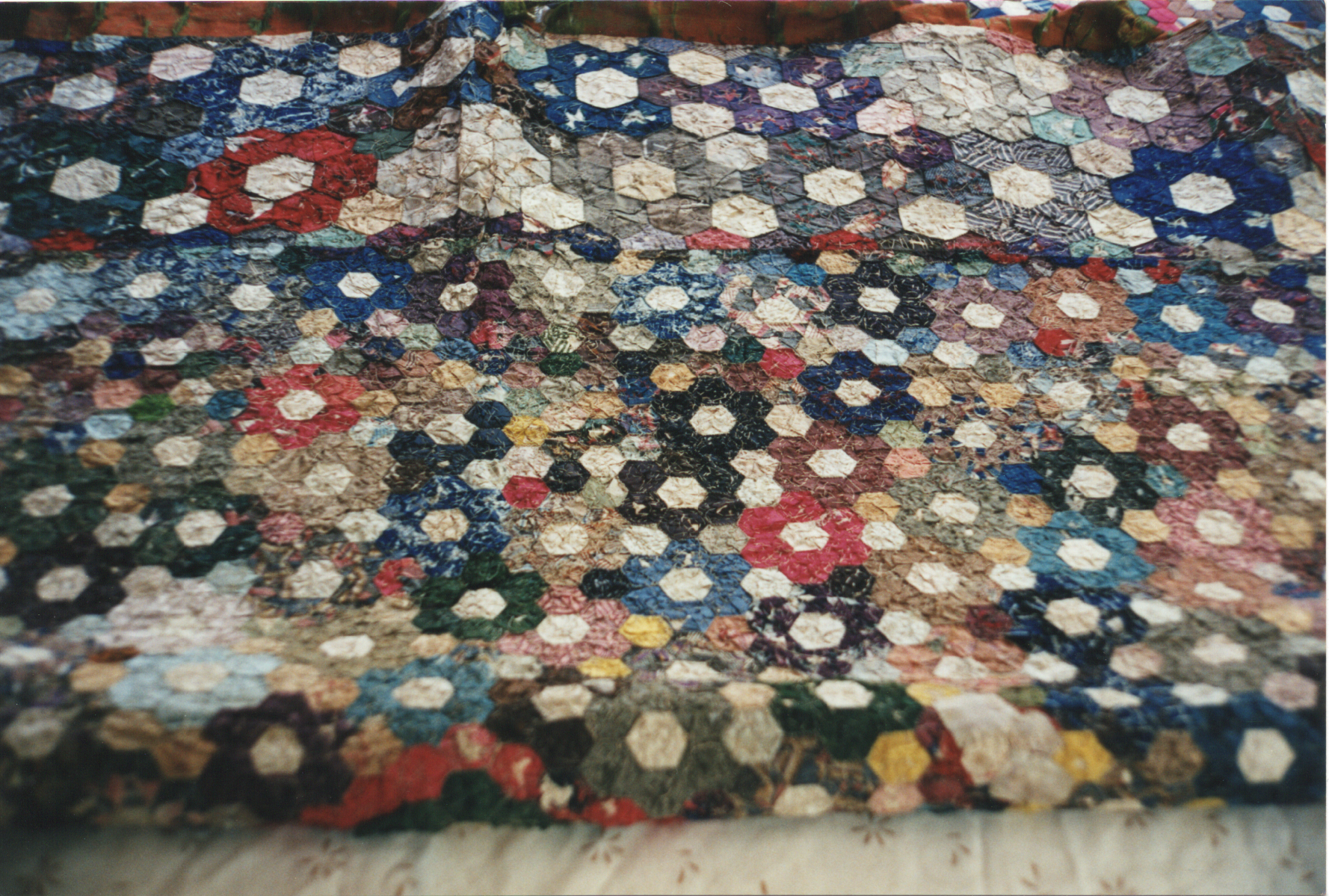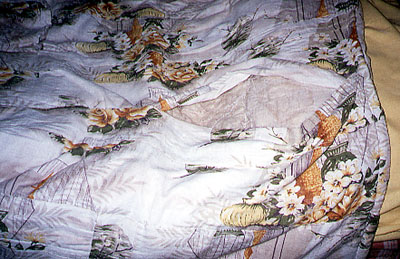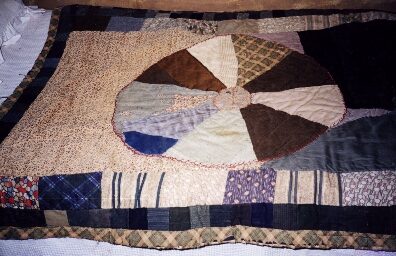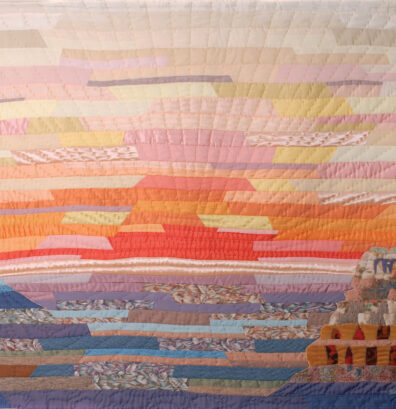-
Owner:
Kew Historical Society Inc -
Location:
Civic Drive, Kew, Victoria, Australia -
Maker:
Denbigh family -
Pattern:
Hexagon -
Dimensions:
Height: 218cm
Width: 217cm
History
Forty-three years ago, a ‘silk patchwork quilt, which was brought from England over one hundred years ago’ entered the collection. Mrs H Johnston’s donation was accepted at the Society’s August 1979 meeting. The quilt was attributed to the Denbigh family of Wimba [Lodge], Cotham Road. Construction of the quilt has been dated to the two decades between 1850 and 1870. Due to its fragile state, it is housed in a high-quality archival box, to prevent further deterioration. The quilt measures 218 x 217 centimetres excluding a shot silk trim, added by machine at a much later date than the body of the work, possibly in the late 1880s.
English born John Sharp Denbigh (1827–75) was the son of a successful auctioneer and broker of the market town of Burnley, Lancashire. Denbigh was a gentleman colonist of the Port Phillip District, arriving on a private chartered ship. He returned to England, and married Jane Roberts (circa 1827–60) in Manchester Cathedral, in 1850. He brought his bride to the ‘Golden Land’, settling in the Parish of Boroondara at a couple of freehold locations: Park Villa, Cotham and Tonawanda, both ‘near Kew’. Jane died at the latter in 1860, aged 33, leaving five children motherless. Did Jane bring the quilt with her on the voyage to Australia?
Three years later, Denbigh married Mary Perry (1835–1924), and they set up house at Wimba. Nothing has been discovered that shines a light on Mary’s pre-nuptial life. Shortly after the marriage, the couple and five children sailed to England, returning on the Champion of the Seas in 1865, with an additional infant, who died on the voyage. John Denbigh recommenced his work as a civil servant working with the Government Mining Department. His new wife gave birth to a further four children at Wimba.
Did Mary inherit the quilt on marriage to her widower husband, or did she work the quilt on the Anglo-Australian sea-voyage to pass the time? Another possibility is that the quilt was sent to Jane or Mary in Australia from England.
The quilt is not an ordinary quilt, compared to those imported to the colony by entrepreneurial merchants as early as 1842. As in England, marriage quilts were very popular in the colony. In the Denbigh Quilt the central design motif points to a marriage quilt. It is a play on triangles. Being three-sided, the triangle represents the Holy Trinity. The intertwining of two triangles forms a six- pointed star representing Solomon’s seal, meaning the soul. Thus, two people merge into one soul, through marriage before God. The central circular motif represents the heavenly domain. The four diamond shapes in the corners are composed of four triangles. They symbolise harmony and stability on earth through the married state. The rest of the design is composed of hexangular facets of silk fabric that have been ‘micro-stitched’ by hand; an art form that was laborious and time consuming, but also a reflection of a woman’s hand-eye co-ordination, finger dexterity, and artistic acuity. A bright quilt upon a bed signified the Christian civilising influence of a woman in the domestic home, particularly in a colony.
However, the juxtaposition of the fabric facets in the artefact, is not a hotchpotch but is highly considered in order to create a harmonising whole of kaleidoscopic colourways. Strictly speaking, the Denbigh quilt is not a quilt but a patchwork of fabric. This is because the underside of the quilt has not been finished with backing. However, this allows for an examination of the construction of the quilt, which uses the English method of quilting. The method involves the use of paper templates to secure the fabric in the required shape and tacked to secure the material for stitching the pieces together. Traditionally, the paper was removed, and the quilt formed by backing and bordering the outside perimeter of the quilt in some manner to create a ‘finish’. Many examples of unbacked quilts survive in Australia, leading to the proposition that this was a reaction to the colonial climate and that they were used as light summer throws.
Summer quilts were imported into the colony from as early as 1840. This then invites an idea that privately ‘brought’ quilts, as well as quilts made in Australia were deliberately not finished. It also suggests the quilt was never washed as the paper templates would perish in water.
Another interpretation of the functionality of quilted fabric was the pre-Federation craze for using such material as a decorative drape for a table or a couch.
It was at this time that Australian women began to abandon English ideas of pattern and construction to respond to local patriotism through the use of Australian motifs, designs and embroidered embellishment. So, it is difficult to assign English or Australian heritage to the artefact. As female heirlooms, these meticulously hand-constructed items were traditionally handed down through the female line and treasured. Perhaps Mary started the quilt and abandoned it having been thrown into instant step-motherhood upon marriage?
What seems certain is the quilt was never sold. Mary became widowed in 1875 after her husband suffered a debilitating, work-stress related death. Their youngest child had been born the year previously. Mary was forced to convert assets into cash. Wimba, and the entire contents of the house were sold. There was no quilt in the inventory of the public auction, although there were bedding and beds advertised.
Further research has uncovered that the quilt was gifted to Mrs Johnston, a next door neighbour, by two Denbigh spinster sisters, the daughters of Denbigh’s first wife, in gratitude for constant care and concern for them as ageing ladies.
In 1916, women who ‘... possessed elaborate old-time quilts were advised to store them carefully, for all too soon they will only be found in museum exhibits’. Today, the collection contains a very fine piece of silk patchwork, stored carefully in an archival textile box to maintain concrete evidence of the female art of manual handcrafting and artistic design.
Source: McWha, Susan. Stories They Tell: a history of Kew through objects, Kew, Kew Historical Society, 2022, pp28-30.
Description
The quilt is constructed in the popular hexagon pattern of silk off-cuts of an earlier period. Hexagon patchwork quilts were typically constructed of individual hexagons, which were formed using paper or card templates. Where these are visible, it would indicate that writing paper was used to form the templates. The quilt is unlined and has a green silk border, added at a later date. Early 19th Century patchwork quilts tended to use cotton to create the hexagons, whereas silk became the preferred medium mid-century. The quilt has been dated to the middle decades of the 19th century due to the colour range, and the exclusion of black silk hexagons. Most of the silk used in the quilt has a sheen, however there is some use of velvet in one or two larger hexagons. The exposed reverse of the quilt includes a large amount of very fine hand stitching.An unlined quilt was typically used as a summer spread.
Acknowledgements
Gift of Helen Johnson, 1979
